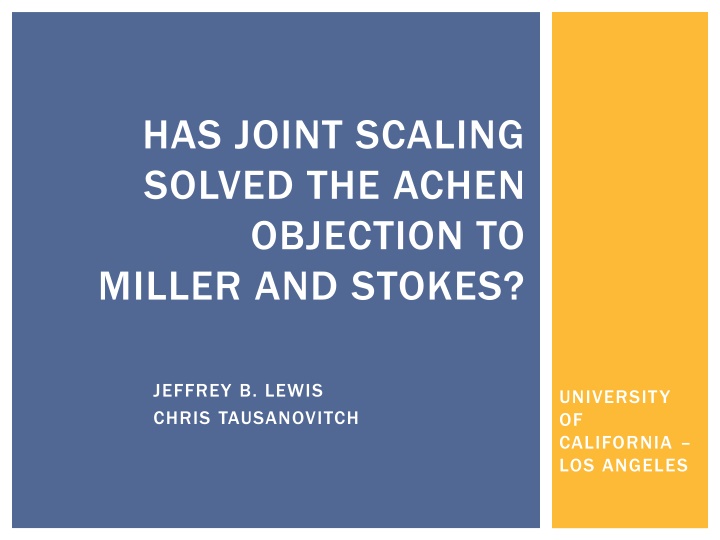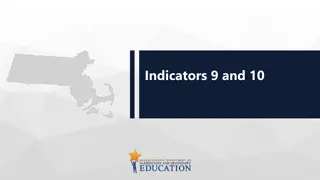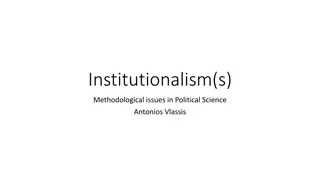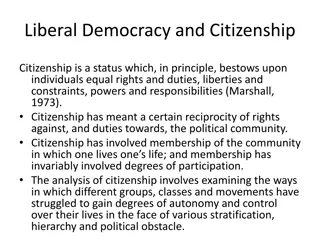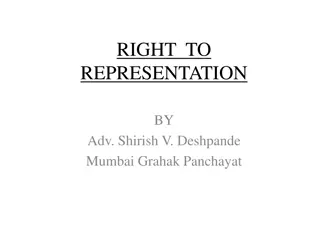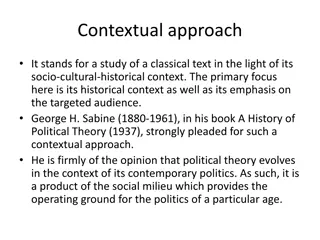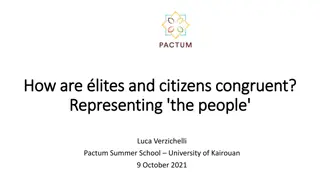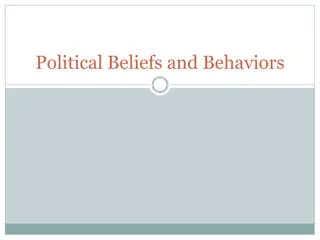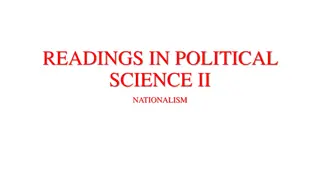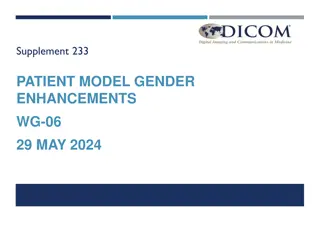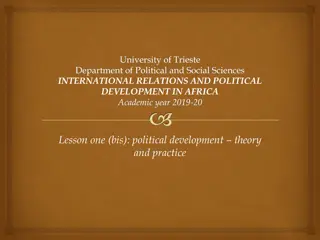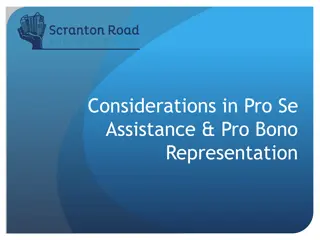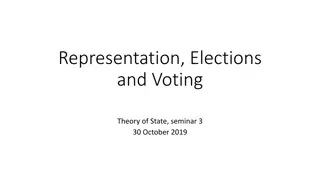Challenges and Solutions in Political Representation Studies
Achen's objection to using correlations as measures of representation has spurred the development of joint scaling models, which aim to address the complexities of public opinion and legislative positioning. However, recent studies question the core assumptions of joint scaling, highlighting the challenges in accurately assessing legislators' relative positions. The debate emphasizes the importance of rigorous testing and the need for diverse measures in political representation research.
Uploaded on Oct 09, 2024 | 1 Views
Download Presentation

Please find below an Image/Link to download the presentation.
The content on the website is provided AS IS for your information and personal use only. It may not be sold, licensed, or shared on other websites without obtaining consent from the author.If you encounter any issues during the download, it is possible that the publisher has removed the file from their server.
You are allowed to download the files provided on this website for personal or commercial use, subject to the condition that they are used lawfully. All files are the property of their respective owners.
The content on the website is provided AS IS for your information and personal use only. It may not be sold, licensed, or shared on other websites without obtaining consent from the author.
E N D
Presentation Transcript
HAS JOINT SCALING SOLVED THE ACHEN OBJECTION TO MILLER AND STOKES? JEFFREY B. LEWIS CHRIS TAUSANOVITCH UNIVERSITY OF CALIFORNIA LOS ANGELES
MOTIVATION Achen (1977,1978) argues that correlations are not good measures of representation. Public opinion may have a different structure than legislative position-taking, and multiple measures are needed (Converse 1964, Ansolabehere, Rodden and Snyder 2008) Joint scaling proposes to solve these problems (Bafumi and Herron 2010) Core identifying assumptions have not been tested 2
TWO TAKEAWAYS In the context of two prominent examples, the core assumption underpinning joint scaling fails statistical tests From a statistical perspective, if we are willing to accept the restrictive assumptions implied by these joint scaling models, we must also accept a wide range of relative locations for legislators and their constituents 3
THE PERILS OF THE CORRELATION A possible data generating process: Now consider a measure of : 4
THE PERILS OF THE CORRELATION What coefficients do we recover from the following model? Not quite the ones we want 5
CONSTITUENT PREFERENCES One solution is to directly compare the positions of legislators to the preferences of constituents However, this comparison may or may not make sense It assumes that ordinary people have the same sorts of preferences that legislators do 6
THE MODEL is person i s response to question j is the ideal point of person i is the discrimination parameter is the difficulty parameter is the cutpoint 7
JOINT SCALING The model defines a function that turns preferences into responses This function varies by item However, we can compare the preference of different groups if we can identify items with the same response function Simple to implement: just make i the same 8
WHAT ARE THE COMMON ITEMS? Roll call questions Ask survey respondents to take positions on roll call votes But these contexts are very different! 10
DIFFERENT CONTEXTS Different content Different information levels Different stakes Different interpretation/understanding 11
A TEST If items do have common item response functions across group, then pooling the groups should not reduce the likelihood of the responses Joint or constrained model: assume that some set of items is common Not joint or unconstrained model: estimate the groups separately 12
DATA Jessee (2009): 111 Senators 5871 survey respondents 27 common items Bafumi and Herron (2010): 629 elected officials (House, Senate, and President) 8219 survey respondents 17 common items Common items are roll call questions 13
ANOTHER TEST When the groups are separately scaled, the item parameters should be linear transformations of each other Separate scalings should differ by only a stretch and a shift As a test, we project estimates item parameters on each other and compare the posterior distributions 18
ANOTHER TEST JESSEE DATA V249 V249 V225 V225 V219 V219 V217 V217 V207 V207 V171 V171 V170 V170 V164 V164 V157 V157 V148 V148 V93 V93 V83 V83 V52 V52 V44 V44 V26 V26 V9 V9 v647 v647 v627 v627 v616 v616 v589 v589 v573 v573 v557 v557 v538 v538 v523 v523 v522 v522 v509 v509 v505 v505 0.0 0.2 0.4 0 1 2 0.4 0.2 2 1 Discrimination Cutpoint 19
ANOTHER TEST HERRON DATA gwbapp gwbapp pr.rcroberts pr.rcroberts pr.rcoil pr.rcoil pr.rcminorabortion pr.rcminorabortion pr.rclineitemveto pr.rclineitemveto pr.rcshiavo pr.rcshiavo pr.rcoverseasabortion pr.rcoverseasabortion pr.rcobesity pr.rcobesity pr.rcmalpractice pr.rcmalpractice pr.rcinternetgamble pr.rcinternetgamble pr.rcalito pr.rcalito pr.youvoteguns pr.youvoteguns pr.youvotebankruptcy pr.youvotebankruptcy pr.youvotepatriot pr.youvotepatriot caftaself caftaself iraqself iraqself stemself stemself 0 2 4 0 2 4 4 2 4 2 Discrimination Cutpoint 20
IMPLICATIONS Not joint model greatly outperforms joint model This occurs due to lower fit of the joint items The common item parameter assumption is not correct for these data 21
HOW BAD IS THIS? Are proximity comparisons with estimates from joint scaling still good approximations? If item parameter assumptions are wrong, we cannot know. However, perhaps out standard was too strict. If we are willing to accept this reduction in likelihood, what differences in the locations of the two groups should we be willing to accept? 22
JESSEE ESTIMATES Estimated distributions Log likelihood reduced by 639 over not joint model 0 1 2 3 3 2 1 ideal point 23
AN EQUIVALENT STRETCH Estimated distributions, with legislators stretched Log likelihood reduced by less than 639 over joint model 0 2 4 6 6 4 2 ideal point 24
AN EQUIVALENT SHRINK Estimated distributions, with legislators dispersion reduced Log likelihood reduced by less than 639 over joint model 0 1 2 3 3 2 1 ideal point 25
AN EQUIVALENT SHIFT LEFT Estimated distributions, legislators shifted left Log likelihood reduced by less than 639 over joint model 0 1 2 4 3 2 1 ideal point 26
AN EQUIVALENT SHIFT RIGHT Estimated distributions, legislators shifted right Log likelihood reduced by less than 639 over joint model 0 1 2 3 4 2 1 ideal point 27
LIKELIHOOD CONTOURS 2.0 1.5 level 0.6500 0.6475 d2 0.6450 0.6425 0.6400 1.0 0.5 0.0 d1 0.5 1.0 1.0 0.5 28
CONCLUSION Proximity comparisons between legislators and constituents do not appear to be valid with current data Remedies are not obvious. Possible directions: Different data Relaxed model assumptions Representation as a mapping between different spaces 29
